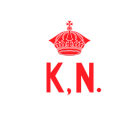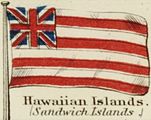Flag of Hawaii
 | |
| Ka Hae Hawaiʻi | |
| Use | Civil and state flag |
|---|---|
| Proportion | 1:2 |
| Adopted | December 29, 1845 |
| Design | Eight alternating horizontal stripes of white, red, and blue, with the United Kingdom's Union Flag (ratio 7:16) in the canton.[1] |
The Flag of Hawaii, or Hawaii Flag, is the official flag of the U.S. state of Hawaii, consisting of a field of eight horizontal stripes, in the sequence white, red, blue, white, red, blue, white, red with a Union Jack in the upper-left corner, or canton. It was first adopted in the early 19th century by the Kingdom of Hawaii and became the official flag when Hawaii joined the United States as the 50th State in 1959.
The use of a British flag is a legacy of the Royal Navy's historical relations with the Hawaiian Kingdom and, in particular, the pro-British sentiment of its first ruler, King Kamehameha I. The current design has been in use since 1845. It was retained through the overthrow of the Hawaiian monarchy in 1893, and continued to be used when Hawaii was a US territory before statehood.
The flag's eight stripes represent the main islands of the Hawaiian archipelago. The colors of the stripes do not have any official symbolism.
History
[edit]Before 1816
[edit]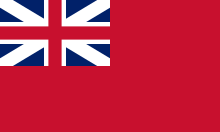
Captain George Vancouver of the British Royal Navy visited the Hawaiian Islands on three occasions during his 1791 to 1795 expedition. At this time, the Hawaiian Islands were divided among several warring chiefdoms. In February 1794, while at anchorage in Kealakekua Bay off the island of Hawaii, Vancouver reached a diplomatic agreement with the king (or aliʻi) of that island, Kamehameha, who would later unite all the Hawaiian islands and become the first ruler of the Kingdom of Hawaii. Vancouver believed that the agreement reached meant Hawaii Island was being ceded to Great Britain but historians have argued that the Hawaiians saw the agreement as establishing a protectorate.[2] After the proceedings on Vancouver's vessel, a British flag was presented, taken ashore and raised. The flag was either a British Union Jack,[3][4] or a Red Ensign as used by the Royal Navy, which features a Union Jack in the canton.[5][6][a] In 1801, the Union Jack added a Saint Patrick's Cross when Ireland joined with Great Britain in a political union. Both pre- and post-1801 versions of the Red Ensign served as the unofficial flag of the Kingdom of Hawaii until 1816.[4]
There is an unverified anecdote that, during the War of 1812 (fought between Great Britain and the United States from 1812 to 1815), Kamehameha became aware of the nationalist meaning of flags. To avoid offending either side, he designed a new flag for his Kingdom which combined elements of both the Union Jack and the flag of the United States at that time.[6][8]: 197
-
Red Ensign of the United Kingdom of Great Britain and Ireland
-
Flag of the United States in 1815 with 15 red and white stripes
1816–1845
[edit]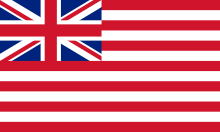

In April 1816, Kamehameha purchased a brig from Scottish Captain Alexander Adams, and arranged for Adams to take command of the ship, which was renamed Kaahumanu. As part of the ship's transfer, the ensign of the East India Company, which consisted of the Union Jack on a field of red-and-white stripes, was taken by Adams during a ceremony with an 11-gun salute.[9] The next year, in March 1817, the Kaahumanu became the first Hawaiian vessel to sail to a foreign port under a "distinct" Hawaiian flag which featured “red, white and blue stripes”.[10][11] The Russian navigator Vasily Golovnin, based on a visit to Oahu in 1818, describes seeing a "national flag" which "consists of seven stripes: red, white, blue, red, white, blue and red, with the English (sic) Union Jack in the corner”.[8]: 185
Until 1845, visitors to the Hawaiian Islands reported various versions of the flag with different numbers of stripes and colors.[12][13]
1845–Present
[edit]In 1843, either as an inadvertent mistake, or as a symbolic “reversal” gesture in the wake of the Paulet affair, the flag design was specified to have eight stripes: a white stripe on top followed by the sequence red, blue, white, red, blue, white, red. This new flag was officially unfurled May 25, 1845 at the opening of the legislative council and remains the same design as used today.[14][12]

Design
[edit]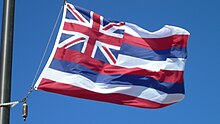
The canton of the flag of Hawaii contains the Union Flag of the United Kingdom, prominent over the top quarter closest to the flag mast. The field of the flag is composed of eight horizontal stripes, symbolizing the eight major islands (Hawaiʻi, Maui, Kahoʻolawe, Lānaʻi, Molokaʻi, Oʻahu, Kauaʻi, and Niʻihau). The color of the stripes, from the top down, follows the sequence: white, red, blue, white, red, blue, white, red. The colors "red", "blue" and "white" are not explicitly defined. Despite resembling the flags of British Overseas Territories, the Hawaiian flag is proportioned differently – the Union Jack in the canton is in a 7:16 ratio.[1]
In 2001, a survey conducted by the North American Vexillological Association (NAVA) placed Hawaii's flag 11th in design quality, out of the 72 U.S. and Canadian provincial, state, and territorial flags ranked.[15]
Lā Hae Hawaiʻi
[edit]In 1990, Governor of Hawaii John Waihee proclaimed July 31 to be Lā Hae Hawaiʻi, the Hawaiian Flag Day. It has been celebrated each year since then.[16] It is the same date as Lā Hoʻihoʻi Ea, Sovereignty Restoration Day, a holiday of the Kingdom of Hawaiʻi that is celebrated by proponents of the Hawaiian sovereignty movement.
Chronology
[edit]Date Flag Image 1793–1800 British Red Ensign[17] 
1801–1816 British Red Ensign following the Acts of Union with Ireland 
1816–1845 Early version of the present flag (1:2 canton) 
February 1843 – July 1843 Union Flag (during the Paulet Affair) 
1845–present The current Hawaiian flag introduced in 1845 (7:16 canton, white stripe at the top). This design was retained through the overthrow of the Kingdom of Hawaii, the Republic of Hawaii, the annexation of Hawaii by the United States, and finally the admission of Hawaii as a US state 
Other Hawaii flags
[edit]Flag of the Governor
[edit]The flag used by the governor of Hawaii is a red and blue bi-color. In the middle of the eight white stars appears the name of the state in all capital letters. During the time Hawaii was a United States territory, the letters in the middle of the flag were "TH", which stood for "Territory of Hawaii".[18]
Kānaka Maoli flag
[edit]
The Kānaka Maoli ('true people' in the Hawaiian language) design is purported by some to be the original flag of the Kingdom of Hawaiʻi, though this claim is unverified and widely disputed.[19][20] It was introduced to the public by Gene Simeona in 2001.[21] It has nine alternating stripes of green, red, and yellow defaced with a green shield with a puela (strip of kapa bark cloth insignia flown atop the double hulled canoe of the chief) crossed by two paddles.
Gene Simeona claims to have unearthed the Kānaka Maoli flag in 1999. Simeona said he encountered a descendant of Lord George Paulet who told him about an earlier flag. Simeona claims to have found evidence of the Kanaka Maoli flag in the state archives, though any sources he may have used have not been identified.[22] Subsequent efforts to verify Simeona's claim have been unsuccessful.[22] Critics of the claim have pointed to evidence of the widely accepted Hawaiian flag being in existence before the Kanaka Maoli flag.[23][22][original research?]

Louis "Buzzy" Agard had proposed a Hawaiian flag design in 1993 which featured nine alternating stripes and the same charge as on the Kanaka Maoli flag,[24] leading many to believe it is where Simeona drew his inspiration.[23]
Despite the lack of verification about its historic use, the design is popular among those who prefer its lack of apparent colonial imagery.[19]
Gallery
[edit]-
Personal Standard of King Kalakaua
-
Personal Standard of Princess Kaiulani
-
Naval Ensign of the Kingdom of Hawaii, with the only known use of this flag being on the Kaimiloa
-
Naval Jack of the Kingdom of Hawaii, flown on the bowsprit of the Kaimiloa
-
Flag of the Kuhina Nui in the Hawaiian Kingdom
-
The inverted Hawaiian flag represents the Hawaiian Kingdom in distress and has served as the main symbol of the Hawaiian sovereignty movement
-
Flag of Hawaiian people used in Unrepresented Nations and Peoples Organization
-
Flag of Nation of Hawaiʻi
-
1868 flag chart
-
Hawaiian quilt from Waimea, before 1918
See also
[edit]- List of flags by design
- List of Hawaii state symbols
- List of U.S. state, district, and territorial insignia
References
[edit]- ^ a b "[§5–19] Description of the Hawaiian flag". Hawaii State Legislature. Retrieved March 11, 2022.
- ^ Bown, Stephen R. (2008). Madness, betrayal and the lash: the epic voyage of Captain George Vancouver. Vancouver: Douglas and McIntyre. pp. 190–191. ISBN 978-1-55365-339-4.
- ^ "Flag of Hawaii | Meaning, History & Facts | Britannica". www.britannica.com. October 1, 2024. Retrieved November 26, 2024.
- ^ a b Healy, Donald T.; Orenski, Peter J. (January 12, 2016). Native American Flags. University of Oklahoma Press. p. 279. ISBN 978-0-8061-5575-3 – via Google Books.
- ^ Fisher, Lynn. "Hawaii". US Flags [dot] Design. Retrieved November 26, 2024.
- ^ a b "The Story Of Hawaii - Story Of Hawaii Museum: 'THE HAWAIIAN FLAG'". storyofhawaiimuseum.com. August 9, 2018. Retrieved November 30, 2024.
- ^ Vancouver, George (1798). A Voyage of Discovery to the North Pacific Ocean and Round the World, Volume 3. London. pp. 56}.
- ^ a b Golovnin, Vasily (1979). Around the world on the Kamchatka, 1817-1819. Honolulu: Hawaiian Historical Society. ISBN 0824806409.
- ^ Fry, Michael (2001). The Scottish Empire. Tuckwell. p. 235. ISBN 978-1-86232-185-4 – via Google Books.
- ^ Native Hawaiians Study Commission: Hearings Before the Committee on Energy and Natural Resources, United States Senate, Ninety-eighth Congress, Second Session, on the Report of the Native Hawaiians Study Commission. Committee on Energy and Natural Resources, US Senate; US Government Printing Office. 1985. p. 427.
- ^ Smith, Whitney (1975). The flag book of the United States. New York: William Morrow. pp. 130–131. ISBN 0688029779.
- ^ a b Ballou, Howard M. (1906). Papers of the Hawaiian Historical Society: The Reversal of the Hawaiian Flag. Honolulu: Hawaiian Gazette Co Ltd. pp. 5–11. ISBN 0-8028-5088-X.
- ^ The Friend. February 1921. pp. 36, 43 – via Google Books.
- ^ Quaife, Milo; Weig, M. J.; Appleman, R. E. (1961). The History of the United States Flag. New York: Harper. p. 154.
- ^ "2001 State/Provincial Flag Survey" (PDF). nava.org.
- ^ "Ka Hae Hawai'i – The Hawaiian Flag". Hawaii Public Radio. Retrieved July 29, 2020.
- ^ All about Hawaii: The Recognized Book of Authentic Information on Hawaii, Combined with Thrum's Hawaiian Annual and Standard Guide. Honolulu Star-Bulletin. 1974.
- ^ "Name and Insignia of Hawaii – Governor's Flag". Hawaii State Library. March 1, 2006. Archived from the original on May 11, 2007. Retrieved October 25, 2007.
- ^ a b "What's the Story Behind Hawaii's Flag?". Hawaii Magazine. October 21, 2008. Retrieved September 21, 2022.
- ^ Pulse, Big Island (August 20, 2019). "Kanaka Maoli Flag – Hawaii's Original Flag or Clever Marketing?". Big Island Pulse. Retrieved September 21, 2022.
- ^ "What's the Story Behind Hawaii's Flag?". Hawaii Magazine. October 21, 2008. Retrieved June 15, 2023.
- ^ a b c Anwar, Yasmin (February 12, 2001). "'Original' flag raises debate". Honolulu Advertiser. Archived from the original on June 4, 2007. Retrieved September 22, 2022.
- ^ a b Kingdom, Hawaiian (December 13, 2014). "Origin of the Hawaiian Kingdom Flag". Hawaiian Kingdom Blog. Retrieved September 22, 2022.
- ^ Agard, Louis "Buzz" (1993). He Alo a He Alo – Hawaiian Voices on Sovereignty. Honolulu: American Friends Service Committee. pp. 108–110. ISBN 9780910082259.
















